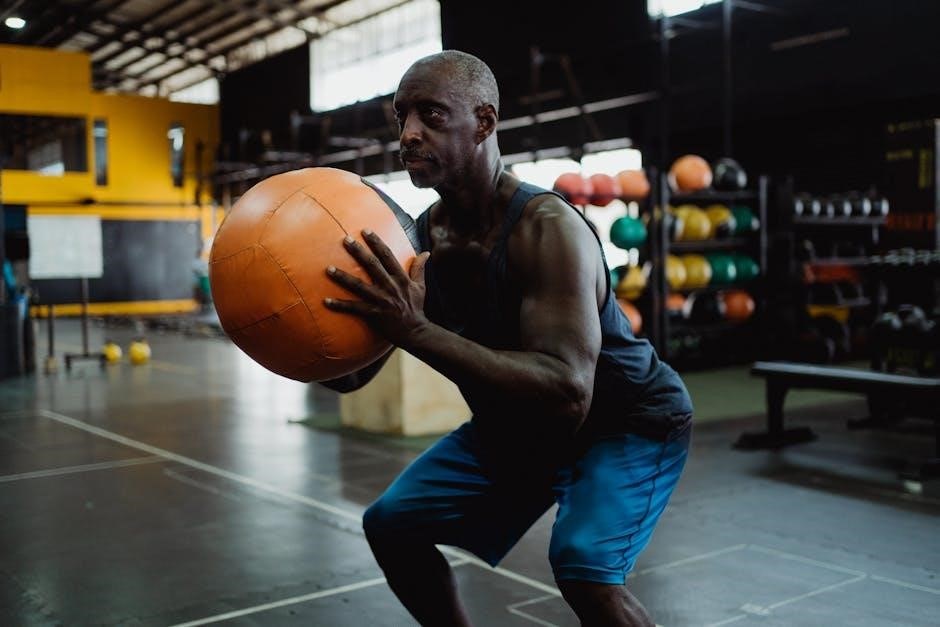scapular strengthening exercises pdf
Scapular strengthening exercises are essential for improving shoulder stability, posture, and overall upper body strength. These exercises target the muscles around the shoulder blades, enhancing stability and reducing injury risk. Regular practice promotes better movement and athletic performance. Discover how to incorporate these exercises into your routine for a stronger, healthier shoulder.
Overview of Scapular Strengthening
Scapular strengthening focuses on enhancing the stability and power of the shoulder blades and surrounding muscles. It involves exercises that target the scapula’s role in shoulder movement, improving posture, and reducing injury risk. Techniques include stabilization, strengthening, and mobility exercises, such as shoulder blade squeezes and seated rows. Regular practice promotes better athletic performance and overall upper body health. A scapular strengthening exercises PDF guide provides structured routines and progressions for effective implementation.
Importance of Scapular Strength
Scapular strength is crucial for maintaining proper shoulder mechanics and preventing injuries. Strong shoulder blades enhance stability, improve posture, and boost athletic performance. Weak scapular muscles can lead to issues like shoulder impingement or winging. Strengthening the scapula improves overall upper body function and reduces pain. Incorporating targeted exercises into your routine ensures a solid foundation for movement and long-term shoulder health, as detailed in a scapular strengthening exercises PDF guide.

Understanding the Anatomy of the Scapula
The scapula, a triangular bone, serves as the attachment point for 17 muscles, playing a vital role in shoulder stability and movement.
Muscles Attached to the Scapula
The scapula is connected to 17 muscles, including the trapezius, rhomboids, levator scapulae, and serratus anterior. These muscles control shoulder movement, stability, and posture. The trapezius and rhomboids stabilize the scapula, while the serratus anterior enables rotation. The supraspinatus, infraspinatus, and subscapularis muscles attach to the scapula, forming the rotator cuff, crucial for shoulder joint stability. Strengthening these muscles enhances overall shoulder function and reduces injury risk.
Role of the Scapula in Shoulder Movement
The scapula plays a vital role in shoulder movement by acting as the base for the shoulder joint and enabling a wide range of motions. It facilitates actions like abduction, rotation, and elevation of the arm. Proper scapular movement ensures efficient energy transfer and maintains shoulder stability during activities. Without effective scapular function, shoulder mobility and strength are compromised, leading to poor posture or injury. Strengthening the scapula enhances overall shoulder mechanics and performance.

Types of Scapular Strengthening Exercises
Scapular strengthening exercises include stabilization, mobility, and strengthening routines. These exercises enhance shoulder stability, posture, and overall upper body strength, reducing injury risk and improving performance.
Scapular Stabilization Exercises
Scapular stabilization exercises focus on improving the control and endurance of the muscles around the shoulder blades. These exercises help maintain proper shoulder blade positioning, enhancing posture and reducing injury risk. Common examples include shoulder blade squeezes, wall slides, and prone shoulder blade exercises. They are often low-intensity and require focus on maintaining proper form. Regular practice strengthens the scapular stabilizers, improving shoulder function and overall upper body stability. These exercises are foundational for athletes and individuals with shoulder issues.
Scapular Strengthening Exercises
Scapular strengthening exercises are designed to enhance the strength and endurance of the muscles surrounding the shoulder blades. These exercises, such as seated rows, lat pulldowns, and scapular push-ups, target the muscles that control shoulder movement. By improving scapular strength, individuals can enhance athletic performance, reduce injury risk, and maintain proper shoulder mechanics. These exercises often involve resistance and focus on controlled movements to build muscle endurance and power, making them essential for both rehabilitation and fitness routines.
Scapular Mobility Exercises
Scapular mobility exercises focus on improving the range of motion and flexibility of the shoulder blades. Techniques like arm circles, chest expansions, and shoulder flexion stretches enhance movement fluidity. These exercises reduce stiffness, prevent scapular winging, and promote better posture. Regular practice ensures the scapula moves efficiently, supporting overall shoulder health and athletic performance. Incorporating mobility work helps maintain scapular stability and reduces the risk of injuries, making it a crucial component of any comprehensive shoulder training program.

Scapular Stabilization Exercises
Scapular stabilization exercises enhance the control and endurance of the muscles around the shoulder blades, improving posture and reducing injury risk. Recommended 3-4 times weekly for optimal shoulder health.
Shoulder Blade Squeezes
Shoulder blade squeezes are a fundamental exercise for improving scapular stability. Stand or sit with good posture, squeeze your shoulder blades together, and hold for 5 seconds. Repeat for 12-15 repetitions. This exercise strengthens the muscles between your shoulder blades, enhancing posture and reducing shoulder strain. Perform 2-3 sets daily for optimal results. Use a mirror to ensure proper form and avoid shrugging your shoulders during the squeeze. This simple yet effective exercise is a cornerstone of scapular strengthening routines.
Wall Slides
Wall slides are an excellent exercise for improving scapular mobility and strength. Stand facing a wall with your hands on it at shoulder height. Slowly slide your hands upward while keeping your shoulders down and away from your ears. Hold for 5 seconds, then lower. Perform 12-15 repetitions. This exercise enhances scapular movement and reduces tightness. Avoid arching your back or shrugging your shoulders. Incorporate wall slides into your routine to promote better shoulder mechanics and overall upper body stability.
Prone Shoulder Blade Exercises
Prone shoulder blade exercises strengthen the scapular muscles while improving posture. Lie on your stomach with arms extended overhead. Slowly lift your arms and shoulders off the ground, squeezing your shoulder blades together. Hold for 5 seconds, then lower. Perform 12-15 repetitions for 3 sets. Focus on controlled movements and avoid shrugging. This exercise enhances scapular stabilization and reduces shoulder tension. Incorporate it into your routine to build a stronger, more stable upper back.

Scapular Strengthening Exercises
Scapular strengthening exercises target key muscles like the trapezius, rhomboids, and levator scapulae. Seated rows, lat pulldowns, and scapular push-ups are effective for building strength and improving posture.
Seated Rows
Seated rows are an effective exercise for targeting the trapezius and rhomboid muscles, which are critical for scapular strength. To perform, sit on a bench with feet flat, grip the bar with hands shoulder-width apart, and pull the bar toward your chest while squeezing your shoulder blades together. Maintain a straight back and engage your core to avoid rounding your shoulders. This exercise improves posture, enhances shoulder stability, and strengthens the muscles necessary for proper scapular function.
Lat Pulldowns
Lat pulldowns are a versatile exercise that targets the latissimus dorsi muscles while engaging the scapular stabilizers. Sit at a lat pulldown machine with knees securely under the pad, grip the bar wider than shoulder-width, and pull it toward your chest. Focus on squeezing your shoulder blades together and maintaining proper form to avoid neck strain. This exercise is effective for building upper body strength and can be adjusted with resistance levels to suit different fitness goals, making it ideal for both beginners and advanced trainees.
Scapular Push-Ups
Scapular push-ups are a modified push-up variation that focuses on activating the shoulder blade muscles. Start in a plank position with hands slightly wider than shoulder-width. Engage your core, lower your body slightly, and pinch your shoulder blades together as you lowers. This exercise strengthens the muscles around the scapula, improving posture and shoulder stability. It’s an excellent bodyweight option for targeting scapular strength without heavy weights. Focus on controlled movements to maximize muscle activation and avoid strain.

Scapular Mobility Exercises
Scapular mobility exercises enhance flexibility and range of motion in the shoulder blades, improving posture and reducing stiffness. Regular practice promotes fluid movement and reduces injury risk.
Arm Circles
Arm circles are a simple yet effective exercise for improving scapular mobility. Stand tall with arms extended at shoulder height. Make small circles forward for 10 reps, then backward for 10 reps. Keep shoulders relaxed and avoid shrugging. Gradually increase circle size as mobility improves. Perform 3 sets daily to enhance flexibility and reduce stiffness. This exercise promotes smooth shoulder blade movement and is ideal for warming up or cooling down. It’s a great starting point for improving overall shoulder health and mobility.
Chest Expansion Exercises
Chest expansion exercises target the muscles around the scapula and chest, improving posture and mobility. Stand in a doorway with arms extended at shoulder height, palms forward. Gently press arms outward, stretching the chest. Hold for 30 seconds and repeat 3 times. This exercise helps reduce rounded shoulders and enhances breathing by opening up the chest. Regular practice improves scapular positioning and overall upper body alignment, making it a valuable addition to any scapular strengthening routine.
Shoulder Flexion Stretch
Stand tall with feet shoulder-width apart. Interlock fingers and stretch arms overhead, palms up. Gently lean back, stretching the front of your shoulders. Hold for 30 seconds, then release. Repeat 3 times. This stretch improves shoulder mobility and reduces tightness in the anterior deltoids. Regular practice helps counteract rounded shoulders and enhances posture, making it an excellent complement to scapular strengthening exercises for overall shoulder health and stability.

Creating a Scapular Strengthening Workout Routine
A well-structured scapular strengthening routine involves targeting stabilization and strength exercises 3-4 times weekly. Start with 3 sets of 10-15 reps, focusing on proper form to prevent injury and maximize effectiveness. Include exercises like shoulder blade squeezes, wall slides, and seated rows. Gradually increase resistance or difficulty as strength improves. Always incorporate a dynamic warm-up and cool-down to enhance mobility and reduce muscle tension. Consistency and progression are key to achieving robust scapular strength and overall shoulder stability.
Frequency and Duration
For optimal results, perform scapular strengthening exercises 3-4 times per week, allowing at least 48 hours of rest between sessions. Each workout should last 20-30 minutes, focusing on 3-4 exercises per session. Start with 3 sets of 10-15 repetitions for each exercise, gradually increasing as strength improves. Consistency is key to building scapular stability and strength; Avoid overtraining, as this can lead to fatigue or injury. Adjust duration and frequency based on individual fitness levels and goals.
Sets and Repetitions
Start with 3 sets of 10-15 repetitions for each scapular strengthening exercise. Gradually increase the number of sets or reps as strength improves. For stabilization exercises, focus on controlled movements and proper form. Higher repetitions (12-20) are ideal for endurance, while lower reps (8-12) with resistance are better for building strength. Adjust sets and reps based on fitness goals and current strength levels. Ensure proper form throughout to maximize effectiveness and prevent injury. Progression should be gradual to avoid overtraining.
Warm-Up and Cool-Down Routines
Begin with a dynamic warm-up, including arm circles, shoulder rolls, and light cardio to prepare the scapular muscles. After exercise, cool down with static stretches like chest stretches and shoulder flexion stretches. Incorporate foam rolling to release tension in the upper back. Heat therapy before exercises and ice afterward can reduce muscle soreness and improve recovery. A proper warm-up and cool-down routine enhances flexibility, prevents injury, and supports overall scapular health. Consistency is key for optimal results.

Progression and Variation of Exercises
Progress your routine by increasing resistance, changing exercise planes, or modifying movements. Advanced exercises include single-arm rows or plyometric push-ups. Always maintain proper form to prevent injury and enhance effectiveness.
Increasing Resistance
Gradually increasing resistance is key to building scapular strength. Start with lighter weights or resistance bands, then progress to heavier loads as strength improves. Use dumbbells, cable machines, or weighted vests to add challenge. Focus on controlled movements to avoid injury. Progressive overload ensures continued muscle growth and improved stability. Incorporate variations like single-arm exercises to target specific muscle groups. Always warm up before increasing resistance to maintain proper form and prevent strain.
Changing Exercise Planes
Changing exercise planes enhances scapular strength by targeting muscles in different directions. Perform exercises in the sagittal, frontal, and transverse planes to improve functional strength. For example, lateral raises (frontal plane) and bench presses (sagittal plane) work the scapula from varied angles. Incorporate rotational movements to challenge stabilizing muscles. Varying planes ensures comprehensive muscle activation, preventing imbalances and improving overall shoulder function. This approach mimics real-life movements, making scapular training more effective and practical for daily activities.
Advanced Scapular Exercises
Advanced scapular exercises challenge the muscles with greater intensity and complexity. Single-arm dumbbell rows and incline bench rows target the scapular stabilizers from different angles. Physioball exercises, like stability work, enhance control and strength. These exercises require proper form and progression to avoid injury. Incorporating varied resistance and dynamic movements improves muscle activation and functional strength. Advanced exercises are ideal for individuals with a solid foundation in scapular stabilization, aiming to elevate their shoulder and upper body performance.

Common Mistakes to Avoid
Common mistakes include improper form, overtraining, and neglecting core engagement. These errors can lead to ineffective workouts or injuries. Always prioritize proper technique and balanced training.
Improper Form
Improper form is a common mistake during scapular exercises, leading to ineffective workouts and potential injuries. Shrugging shoulders, not engaging the core, and not squeezing shoulder blades are frequent errors. These mistakes can strain muscles and reduce exercise efficiency. To avoid this, use mirrors to monitor posture, start with lighter weights, and focus on slow, controlled movements. Proper form ensures exercises target the right muscles, enhancing strength and stability. Always prioritize technique to maximize benefits and prevent harm.
Overtraining
Overtraining can lead to muscle fatigue, reduced performance, and increased injury risk. Performing scapular exercises too frequently without adequate recovery can strain the muscles. It’s important to balance workout intensity and allow time for recovery. Overtraining can also cause poor form, reducing exercise effectiveness. Ensure to rest between sessions and avoid excessive repetitions. If pain or fatigue persists, consult a professional to adjust your routine and prevent long-term damage. Proper recovery is key to achieving scapular strength and stability.
Neglecting Core Engagement
Neglecting core engagement during scapular exercises can lead to poor form and reduced effectiveness. The core provides stability, allowing proper muscle activation. Without it, exercises may strain shoulders or other compensatory muscles. This can hinder progress and increase injury risk. Engage your core to maintain control and ensure exercises target the correct muscles. Proper core activation enhances exercise efficiency and promotes safe, effective scapular strengthening.

Scapular Strengthening Exercises PDF Guide
A comprehensive guide detailing exercises, routines, and progressions to enhance scapular strength and stability. Includes sample routines, tips, and visual aids for proper form and technique.
Sample Exercise Routine
A well-structured routine includes exercises like shoulder blade squeezes, wall slides, and seated rows. Start with 3 sets of 10-15 reps for each exercise, 3-4 times weekly. Begin with light resistance and gradually increase. Include prone shoulder blade exercises to target stabilizers. Warm up with arm circles and finish with a cool-down stretch. This balanced approach ensures scapular strength, stability, and mobility, reducing injury risk and enhancing overall shoulder function. Adjust as needed based on fitness level and goals.
Progression Plan
Begin with basic stabilization exercises like shoulder blade squeezes and wall slides. Gradually introduce resistance using light weights or bands. Progress to advanced movements such as seated rows and lat pulldowns. Increase resistance or reps as strength improves. Incorporate dynamic exercises like scapular push-ups to challenge stability; Ensure proper form throughout progression to avoid injury. Aim to increase intensity every 4-6 weeks, focusing on muscle endurance and power. This structured approach ensures continuous improvement in scapular strength and function.
Scapular strengthening exercises are crucial for improving posture, reducing injury risk, and enhancing athletic performance. Regular practice promotes long-term shoulder health and overall physical fitness.
Final Thoughts on Scapular Strengthening
Consistency is key when it comes to scapular strengthening. Regular exercises improve posture, reduce injury risk, and enhance athletic performance. Focus on proper form to maximize benefits. Incorporate a mix of stabilization, strength, and mobility exercises for a balanced routine. Over time, stronger scapular muscles will support better overall shoulder health and movement efficiency. Prioritize these exercises to build a solid foundation for long-term fitness and injury prevention.
Additional Resources
Explore detailed PDF guides and instructional videos online for comprehensive scapular strengthening routines. These resources offer step-by-step instructions and expert recommendations to enhance your workout plan effectively.
Recommended Reading
For in-depth guidance, explore PDF guides and academic articles on scapular strengthening. Resources from sports medicine websites and physical therapy portals offer expert advice. Look for detailed exercise manuals, progress tracking sheets, and anatomical illustrations. Many orthopedic and sports medicine organizations provide free downloadable PDFs. These materials often include routines tailored to different fitness levels, ensuring a structured approach to improving scapular strength and stability. Prioritize sources from reputable medical or fitness institutions for reliable information.
Further Exercise Videos
Enhance your workout routine with instructional videos demonstrating scapular strengthening exercises. Platforms like YouTube and fitness websites offer tutorials by physical therapists and trainers. These videos provide visual guidance for proper form and technique. Look for routines that include exercises like shoulder blade squeezes, wall slides, and prone shoulder drills. Many videos cater to different fitness levels, ensuring you can progress safely. Utilize these resources to complement your PDF guide and achieve optimal scapular strength and stability through visual learning.

